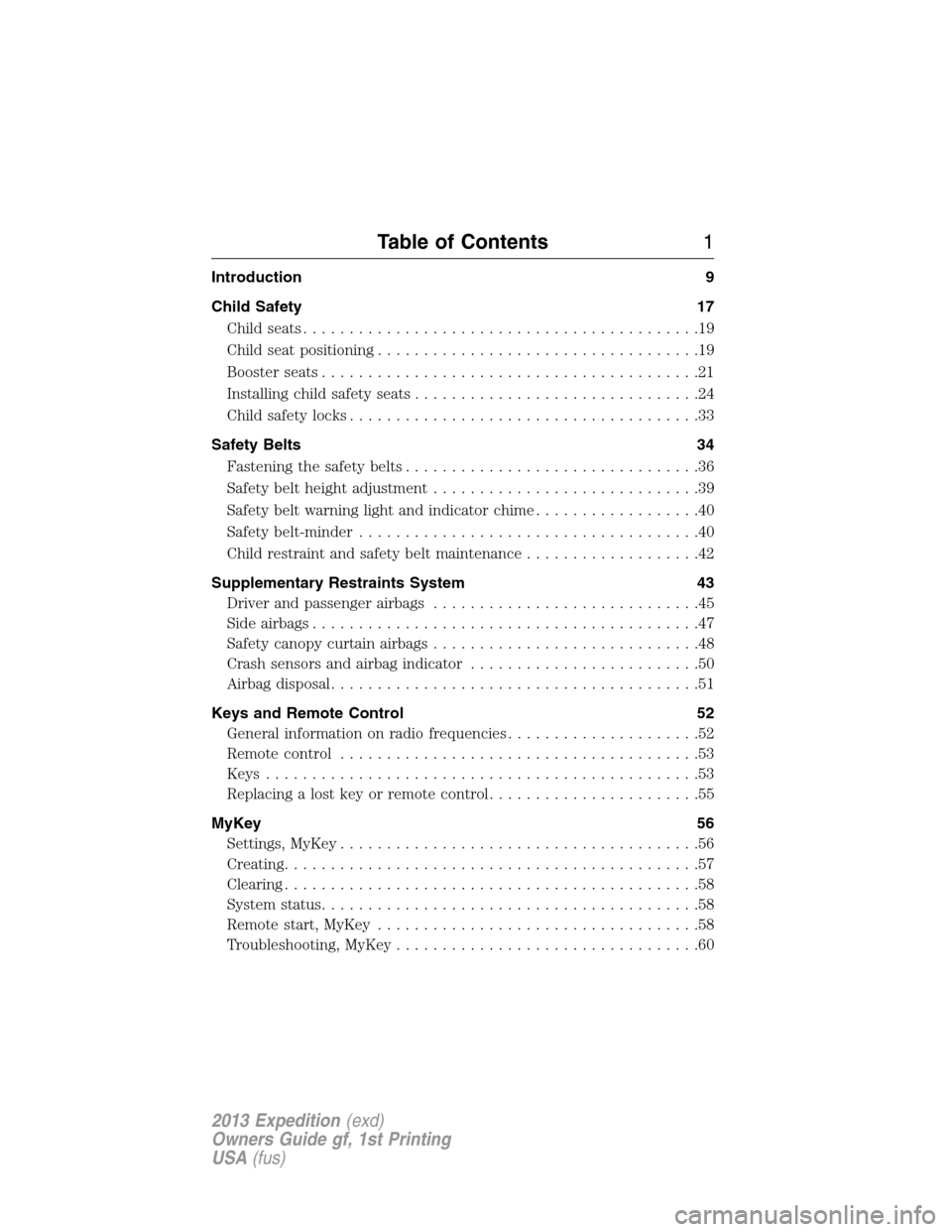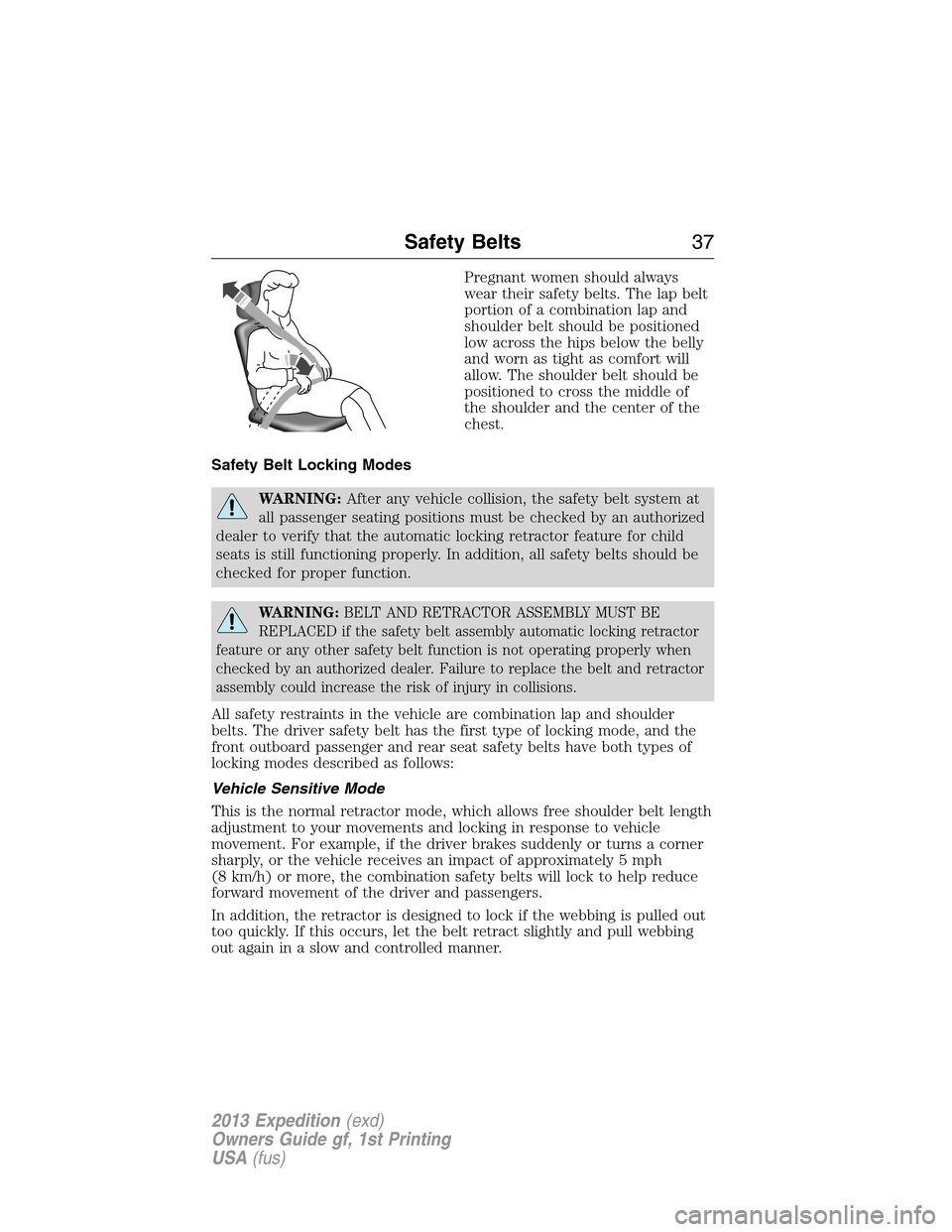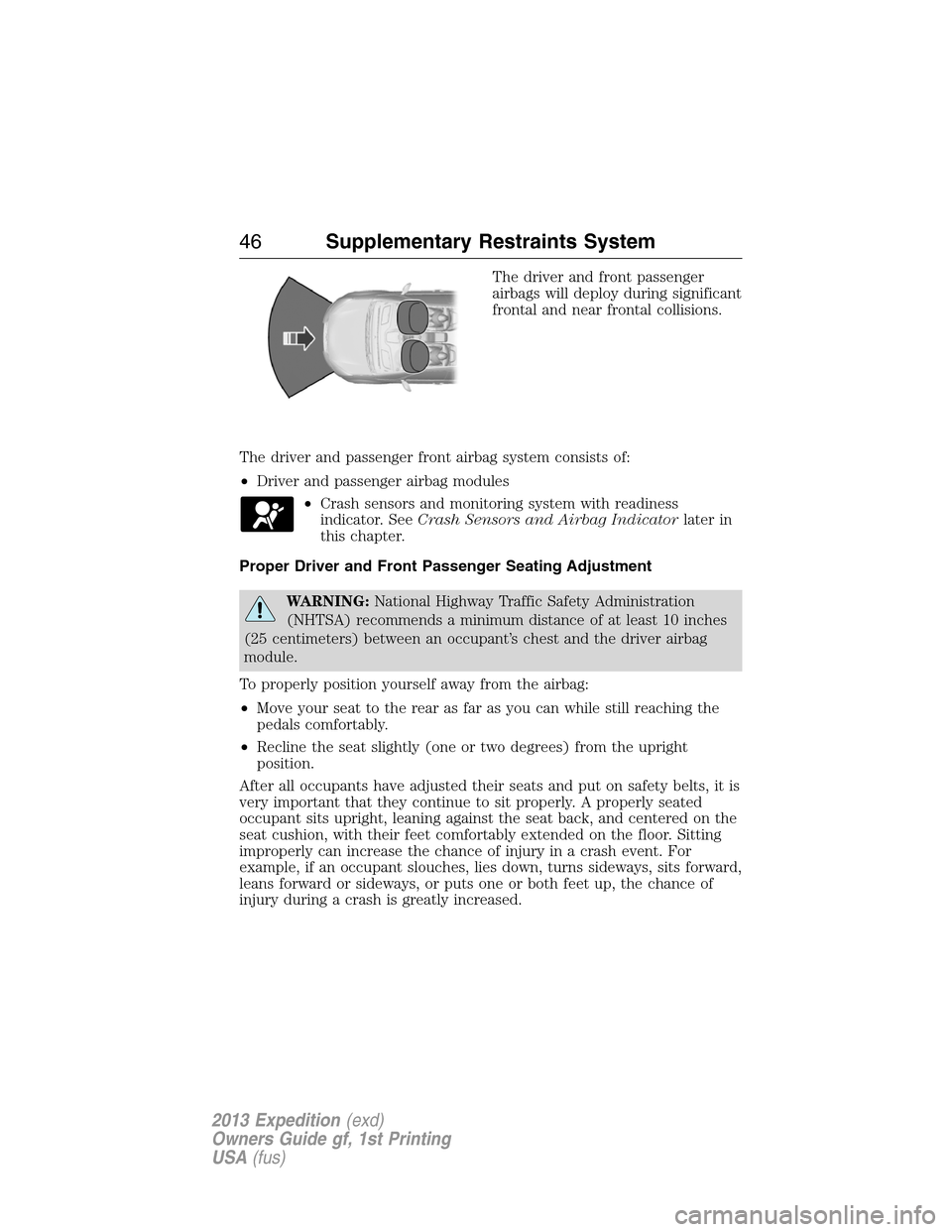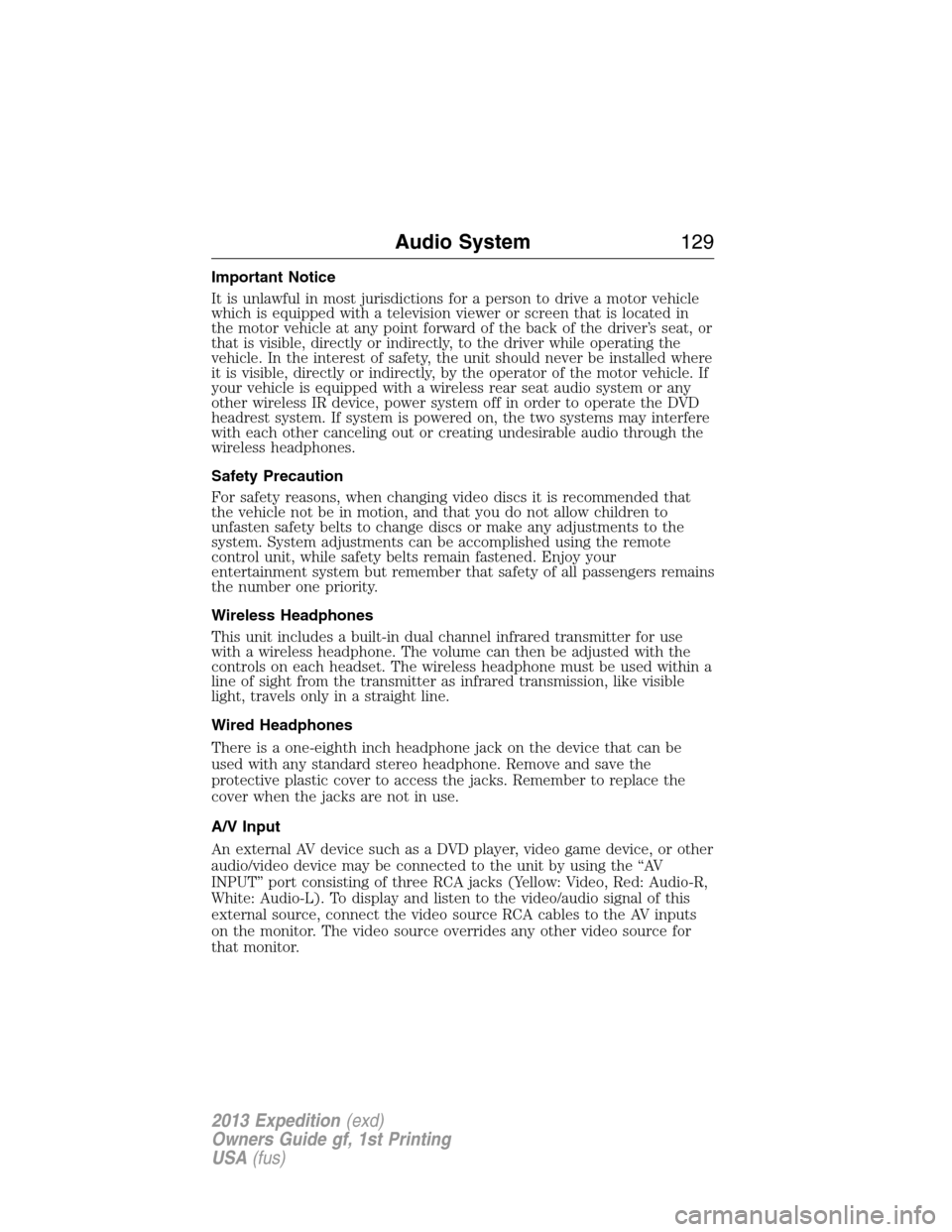driver seat adjustment FORD EXPEDITION 2013 3.G Owners Manual
[x] Cancel search | Manufacturer: FORD, Model Year: 2013, Model line: EXPEDITION, Model: FORD EXPEDITION 2013 3.GPages: 497, PDF Size: 5.64 MB
Page 1 of 497

Introduction 9
Child Safety 17
Child seats...........................................19
Child seat positioning...................................19
Booster seats.........................................21
Installing child safety seats...............................24
Child safety locks......................................33
Safety Belts 34
Fastening the safety belts................................36
Safety belt height adjustment.............................39
Safetybeltwarninglightandindicatorchime..................40
Safety belt-minder.....................................40
Child restraint and safety belt maintenance...................42
Supplementary Restraints System 43
Driver and passenger airbags.............................45
Side airbags..........................................47
Safety canopy curtain airbags.............................48
Crash sensors and airbag indicator.........................50
Airbag disposal........................................51
Keys and Remote Control 52
General information on radio frequencies.....................52
Remote control.......................................53
Keys...............................................53
Replacing a lost key or remote control.......................55
MyKey 56
Settings, MyKey.......................................56
Creating.............................................57
Clearing.............................................58
System status.........................................58
Remote start, MyKey...................................58
Troubleshooting, MyKey.................................60
Table of Contents1
2013 Expedition(exd)
Owners Guide gf, 1st Printing
USA(fus)
Page 37 of 497

Pregnant women should always
wear their safety belts. The lap belt
portion of a combination lap and
shoulder belt should be positioned
low across the hips below the belly
and worn as tight as comfort will
allow. The shoulder belt should be
positioned to cross the middle of
the shoulder and the center of the
chest.
Safety Belt Locking Modes
WARNING:After any vehicle collision, the safety belt system at
all passenger seating positions must be checked by an authorized
dealer to verify that the automatic locking retractor feature for child
seats is still functioning properly. In addition, all safety belts should be
checked for proper function.
WARNING:BELT AND RETRACTOR ASSEMBLY MUST BE
REPLACED if the safety belt assembly automatic locking retractor
feature or any other safety belt function is not operating properly when
checked by an authorized dealer. Failure to replace the belt and retractor
assembly could increase the risk of injury in collisions.
All safety restraints in the vehicle are combination lap and shoulder
belts. The driver safety belt has the first type of locking mode, and the
front outboard passenger and rear seat safety belts have both types of
locking modes described as follows:
Vehicle Sensitive Mode
This is the normal retractor mode, which allows free shoulder belt length
adjustment to your movements and locking in response to vehicle
movement. For example, if the driver brakes suddenly or turns a corner
sharply, or the vehicle receives an impact of approximately 5 mph
(8 km/h) or more, the combination safety belts will lock to help reduce
forward movement of the driver and passengers.
In addition, the retractor is designed to lock if the webbing is pulled out
too quickly. If this occurs, let the belt retract slightly and pull webbing
out again in a slow and controlled manner.
Safety Belts37
2013 Expedition(exd)
Owners Guide gf, 1st Printing
USA(fus)
Page 46 of 497

The driver and front passenger
airbags will deploy during significant
frontal and near frontal collisions.
The driver and passenger front airbag system consists of:
•Driver and passenger airbag modules
•Crash sensors and monitoring system with readiness
indicator. SeeCrash Sensors and Airbag Indicatorlater in
this chapter.
Proper Driver and Front Passenger Seating Adjustment
WARNING:National Highway Traffic Safety Administration
(NHTSA) recommends a minimum distance of at least 10 inches
(25 centimeters) between an occupant’s chest and the driver airbag
module.
To properly position yourself away from the airbag:
•Move your seat to the rear as far as you can while still reaching the
pedals comfortably.
•Recline the seat slightly (one or two degrees) from the upright
position.
After all occupants have adjusted their seats and put on safety belts, it is
very important that they continue to sit properly. A properly seated
occupant sits upright, leaning against the seat back, and centered on the
seat cushion, with their feet comfortably extended on the floor. Sitting
improperly can increase the chance of injury in a crash event. For
example, if an occupant slouches, lies down, turns sideways, sits forward,
leans forward or sideways, or puts one or both feet up, the chance of
injury during a crash is greatly increased.
46Supplementary Restraints System
2013 Expedition(exd)
Owners Guide gf, 1st Printing
USA(fus)
Page 129 of 497

Important Notice
It is unlawful in most jurisdictions for a person to drive a motor vehicle
which is equipped with a television viewer or screen that is located in
the motor vehicle at any point forward of the back of the driver’s seat, or
that is visible, directly or indirectly, to the driver while operating the
vehicle. In the interest of safety, the unit should never be installed where
it is visible, directly or indirectly, by the operator of the motor vehicle. If
your vehicle is equipped with a wireless rear seat audio system or any
other wireless IR device, power system off in order to operate the DVD
headrest system. If system is powered on, the two systems may interfere
with each other canceling out or creating undesirable audio through the
wireless headphones.
Safety Precaution
For safety reasons, when changing video discs it is recommended that
the vehicle not be in motion, and that you do not allow children to
unfasten safety belts to change discs or make any adjustments to the
system. System adjustments can be accomplished using the remote
control unit, while safety belts remain fastened. Enjoy your
entertainment system but remember that safety of all passengers remains
the number one priority.
Wireless Headphones
This unit includes a built-in dual channel infrared transmitter for use
with a wireless headphone. The volume can then be adjusted with the
controls on each headset. The wireless headphone must be used within a
line of sight from the transmitter as infrared transmission, like visible
light, travels only in a straight line.
Wired Headphones
There is a one-eighth inch headphone jack on the device that can be
used with any standard stereo headphone. Remove and save the
protective plastic cover to access the jacks. Remember to replace the
cover when the jacks are not in use.
A/V Input
An external AV device such as a DVD player, video game device, or other
audio/video device may be connected to the unit by using the “AV
INPUT” port consisting of three RCA jacks (Yellow: Video, Red: Audio-R,
White: Audio-L). To display and listen to the video/audio signal of this
external source, connect the video source RCA cables to the AV inputs
on the monitor. The video source overrides any other video source for
that monitor.
Audio System129
2013 Expedition(exd)
Owners Guide gf, 1st Printing
USA(fus)